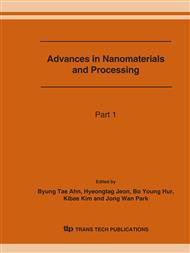p.97
p.101
p.105
p.109
p.113
p.119
p.123
p.127
p.131
Growth and Characterization of GaN Nano-Column Grown on Si (111) Substrate Using Au+Ga Alloy Seeding Method by MOCVD
Abstract:
We have studied the Au+Ga alloy seeding method. Single-crystal GaN nano-column arrays were grown using metalorganic chemical vapor deposition (MOCVD) and their properties were investigated as a function of the growth parameters and Au thin film thickness. Au-coated Si(111) substrates were used for the growth of GaN nano-columns. The diameter and length of as-grown nano-column ranged from 100 to 500 nm and 1 to 5 μm, respectively. The morphology of the columns was investigated using scanning electron microscopy. Energy dispersive X-ray spectroscopy and photoluminescence were used for evaluating of its qualitative analysis and to evaluate the optical properties, respectively. Two important growth parameters were considered, the thickness of the Au thin film and the gallium flow rate. The density and tendency of the nano-columns depend on each of these growth parameters. It is believed that the catalytic activity of gold is determined by the size of the Au+Ga solid solution particles, and smaller Au+Ga clusters showed significant reactivity in the growth of one-dimensional GaN nano structures.
Info:
Periodical:
Pages:
113-118
Citation:
Online since:
June 2007
Authors:
Keywords:
Price:
Сopyright:
© 2007 Trans Tech Publications Ltd. All Rights Reserved
Share:
Citation:


